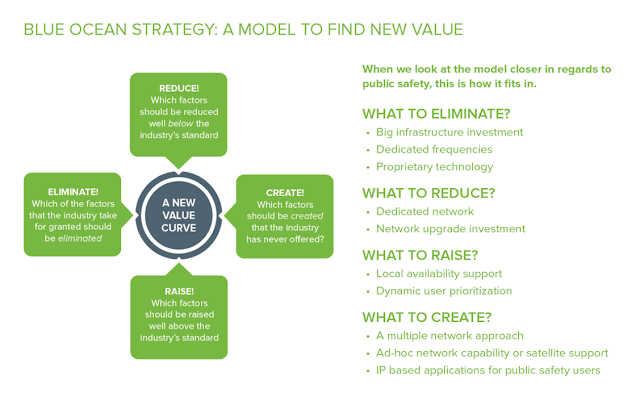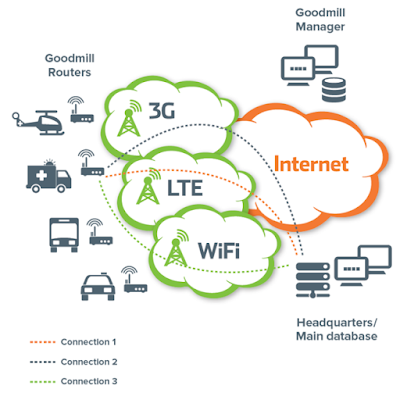The ultimate public safety broadband solution is a blue ocean one
15.09.2017In the past, there have been huge investments into public safety networks around the world. Investments into digital voice solutions with country-wide coverage are still ongoing in many countries, with Germany and Norway being the latest and widest implementations. Big infrastructure providers have been earning good revenue with these national roll-outs. Now, as the old technology cannot provide the data rates required, many of the traditional players are planning on selling new broadband networks the same way in the future.
There is however, a new ‘Blue Ocean’ concept that changes the whole business model for public safety broadband. This is good news for taxpayers, but poses a significant risk for the previous rulers of the marketplace. Before I get to that, let’s summarize what ‘Blue Ocean’ in this case stands for.
INTRODUCTION TO BLUE OCEAN STRATEGY (BOS)
This term was invented by W. Chan Kim and Renée Mauborgne in their book “Blue Ocean Strategy: How to Create Uncontested Market Space and Make Competition Irrelevant”. The idea is that you don’t only develop and enhance your offering to win markets, but you can redefine it by introducing aspects of elimination and reduction. With the new model, we can reduce or even eliminate investments into new networks and simultaneously improve data security, reliability, coverage and resilience. And all this at a fraction of the cost of the old business model.
>> WITH THE NEW MODEL, WE CAN REDUCE OR EVEN ELIMINATE INVESTMENTS INTO NEW NETWORKS AND SIMULTANEOUSLY IMPROVE DATA SECURITY, RELIABILITY, COVERAGE AND RESILIENCE

THE DILEMMA OF OVERSERVING THE PUBLIC SAFETY COMMUNICATION MARKET
Whenever talking about public safety, the argumentation for selling solutions has been around the importance of the service itself. I’ve heard arguments like “TETRA is the only technology you can trust on your life” or “dedicated and government controlled networks are the only solutions that fulfill the availability and resilience needs of public safety”. As we know that Tetra is far better suited for critical communications than a single commercial network, these statements are still not true. The digital PMR, when introduced, was the only suitable solution. It has given over the years us great benefits, is very useful today and will continue to add value in the future. However, we also know of numerous situations where TETRA, Tetrapol or P25 networks have been down or unusable due to congestion problems. These, like any single network solutions, are still vulnerable to storms and other natural catastrophes. The dedicated PMR networks too often get overcrowded when needed most. Simultaneously, when there’s nothing important going on, the networks are using even as little as 2-5% of their capacity. This means that there is a huge investment standing unused most the time, yet failing unfortunately often when needed the most. If this is what the current situation is, do we really need dedicated networks business model in the future? Are there solutions that can outperform the availability and resilience of a single network investment? I think these are questions worth asking.
ALTERNATIVE APPROACHES TO PUBLIC SAFETY COMMUNICATION
The new strategic alternative comes from eliminating the need for new networks. We already see solutions for fixed landline based internet where dedicated secure networks are built inside a commercially available one. VPN tunneling or MPLS technologies are commonly used in the PS sector today. The solution is to combine commercial networks, as many as one wishes, and use secure tunnels inside them. This way, the existing infrastructure of all mobile operators can be used, taking advantage of the resilience, availability and operational security they can serve together.

This is very important to understand: the existing, separate networks can offer these benefits when used in unison. The same reason we have two ears and eyes. It is possible using these separate networks to have secure tunneling running simultaneously across them all. This means that the costs of the solution are magnitudes lower than building an entirely new network anywhere with any significant coverage.
To read more about the ultimate solutions, check this white paper.
Juhani Lehtonen, VP
Goodmill Systems
+358 50 572 5542
